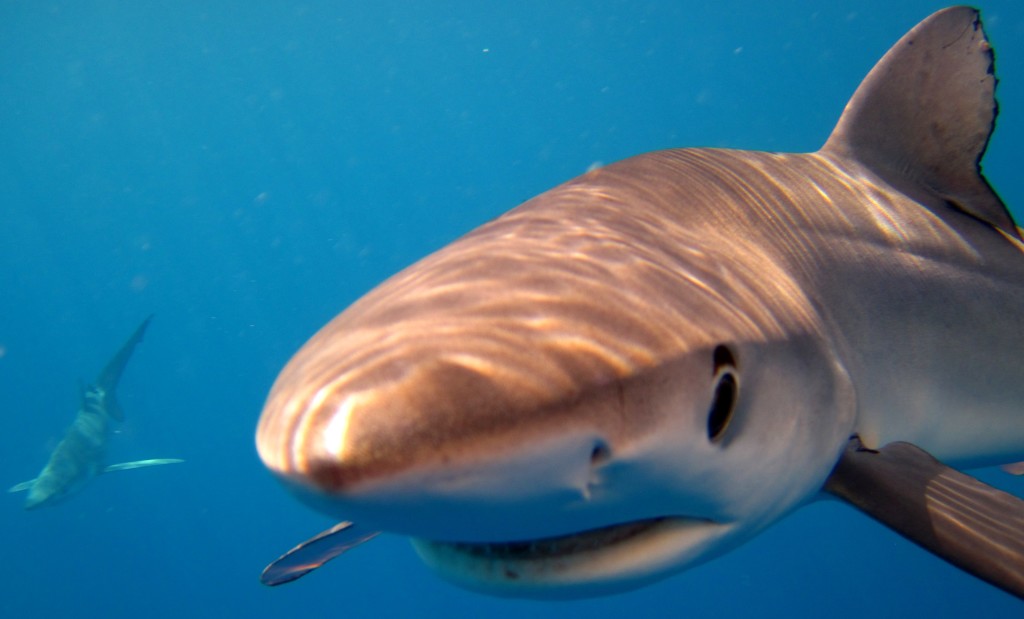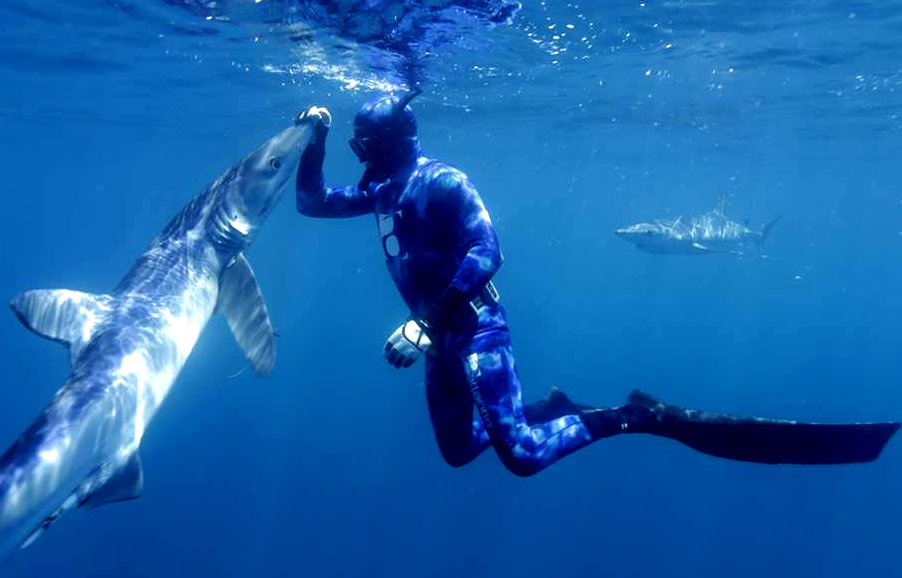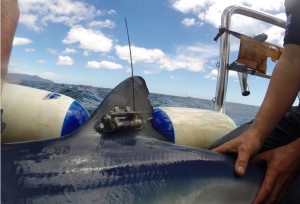Blue sharks swim on
We know very little about blue sharks, which can sometimes be a bad thing for the species. Christopher Reive reports.

It stalks from below, biding its time. When the moment is right it goes for the kill, savouring every succulent bite.
Feeding on squid and tuna, the blue shark rises to the shallows of the epipelagic zone – where light penetrates the ocean – as the warmer waters allow its food to be digested faster.
A highly migratory creature, it conserves energy in the ocean’s depths and moves to where prey can be found, using its sense of electromagnetic reception to navigate.
The blue shark is one of 112 shark species known to inhabit New Zealand waters, and is the most common bycatch species of longline tuna fisheries – making up to 50% of the total catch.
Blue sharks are particularly vulnerable to finning and very little is known about them. Yet blue shark scientist Riley Elliott missed out on scholarship funding from the Ministry for Primary Industries and instead relies on public donations to fund his research.
Elliott has already played his part in one victory – bringing forward a ban on shark finning for the species – but he remains critical of the quota management system, which he says is set in the absence of required data when it comes to sharks.
The win over shark finning, with a ban coming into force late 2013, came after Elliott helped rally huge public pressure.
More than 100 countries have banned the practice of finning sharks and dumping the carcasses at sea, and in 2013 New Zealand took a step toward joining the list.
The Ministry for Primary Industries (MPI) released a national plan of action for the conservation and management of sharks that outlined plans set to be put in place to abolish this practice.
The plan was to be implemented in three stages. A first tranche of species would be protected under the new law by October 2014, a second tranche by October 2015, and blue sharks in 2016.
“It seemed like they’d gone half way to solving the problem, then gave up. They recognised it, said how to solve it, but were going to try and implement it in three years.” – Riley Elliott
That wasn’t soon enough for Elliott and the New Zealand Shark Alliance. Each year, 80,000 blue sharks were killed for their fins, and this wait would see the species suffer three more years of being subject to this wasteful practice.
They set out to rally for a ban to be implemented for all sharks at the same time, saying the delay was unnecessary.
Elliott says while the ministry’s plan of action (known as the NPOA-Sharks) took a step in the right direction, MPI were still not doing as much as they could to protect sharks in New Zealand waters.
“It seemed like they’d gone half way to solving the problem, then gave up. They recognised it, said how to solve it, but were going to try and implement it in three years,” he says.
MPI senior communications advisor Mark Smith says the original time frame given was to allow the ministry to explore markets for blue shark meat so more of the shark could be used if it was caught and killed.
“There are very few markets for blue shark meat, as it is known to ammoniate (spoil) very quickly, it is high in mercury and is generally considered unpalatable. As a result, fishers have historically kept the fins of blue sharks as a way of getting some value from the catches,” Smith says.
Elliott says another reason for the delay in implementing the ban was so MPI could educate fisheries about how to release large sharks safely, which is “as easy as cutting a line.”
His role in the successful campaign to bring the ban forward was to raise awareness of the issue through the media – both social media and news media.
Smith says MPI received over 45,000 submissions regarding the movement.
“Many of the submissions were clear that they believed that a finning ban should be done as soon as possible and not spread over two years as was proposed in the NPOA-Sharks,” he says.
The result was a ban on the finning and dumping of carcasses at sea of any shark implemented as of 1 October 2014.
For spiny dogfish and all non-quota management system (QMS) shark species, fins must reach the shore naturally attached to the body of the shark.
Blue shark fins are allowed to be taken from the body of the shark at sea, but must be artificially attached to the body on return to shore.

Seven QMS species – elephantfish, ghost shark, mako shark, pale ghost shark, porbeagle shark, rig, and school shark – have been put on a ratio list to reduce wastage from fisheries.
The ratio system is set up so only a certain amount of the catch of a species can be fins.
Though the new laws ban slicing fins off and dumping carcasses at sea, they do not prevent fisheries from catching sharks and selling their fins, liver and meat.
For QMS species, fishers are expected to separate fins from the body of the shark to be compared to the greenweight (wholeweight) of that species, as fins may only weigh a certain amount of the catch brought back to shore.
Amendments have been made, however, that allow fishers to dispose of carcasses at sea, provided they record them against their total allowable catch for the species and the fisher’s annual catch entitlement.
Elliott says although the QMS has positives in capping amounts of sharks utilised, a lot of the numbers that quotas are based on have no real substance – especially for highly migratory species, such as the blue shark.
“If you look at the quotas for the main shark species, the highly migratory ones, the quotas have never even really got close to reaching the cap limit or even half way, which shows how ridiculous these limits are – they’re based on nothing,” he says.
“I’ve got a lot of faith in the Quota Management system, but when it comes to making numbers up for the quota for an apex predator that we have no understanding of its stock size, it seems really ridiculous.”
The ban may be having a small but measurable effect.
As of July 31, 2015, available provisional information shows total catches are roughly five percent less than at the same time last year for blue shark, elephant fish, ghost shark, pale ghost shark, mako shark, porbeagle shark, rig, school shark, and spiny dogfish.
This information also shows that the proportion of the catch that has been returned to the sea alive has doubled from one and a half percent to three percent following the introduction of the new laws.
Smith says MPI will continue to monitor catches and processing of sharks for the remainder of the year, and will report back on the success of the new laws once all catch records are available. He expects this will be in late 2015 or early 2016.
Green Party MP Gareth Hughes, who campaigned for five years for a ban on shark finning, says we should be taking an ecosystem approach to fisheries management, rather than focussing on individual species.
New Zealand are stragglers when it comes to the percentage of our waters that are protected marine reserves at only 0.41% – a number Hughes says is “woefully insufficient.”
“Being a maritime superpower with the fourth largest EEZ [exclusive economic zone] in the world I think we have an important role to play in marine science,” Hughes says.
One of the objectives mentioned in the 2013 NPOA-Sharks is to gain a better understanding of the population dynamics in highly migratory species, which is only possible through further scientific study.
To do so, “MPI has contracted research looking at the age, growth and reproduction of highly migratory species of sharks derived from MPI Observer records,” Smith says.
Despite MPI wanting to better understand blue sharks and other highly migratory species, Elliott has been given no funding from the ministry for his research. He relies on New Zealanders to get behind his work and donate toward it.
Smith says Elliott’s proposal was submitted as part of a larger funding process in which expressions of interest were sought for topics covering the entire range of responsibilities of MPI, not just fisheries management.
“There were a large number of applicants for a limited number of scholarships. Following a rigorous selection process it was decided that Mr Elliott’s application was not one of the preferred proposals and was therefore not successful as part of this funding round,” Smith says.
“It is of note that NIWA has considerable expertise in research on shark population biology and dynamics including those for blue sharks and have participated in a number of processes aimed at stock wide assessment of highly migratory sharks,” he adds.
Donations have allowed Elliott to purchase a number of tags, which he has placed on 16 blue sharks to date.

New Zealand waters. Photo: supplied.
During his research, Elliott often swims with blue sharks, and says being in the ocean alongside them makes him appreciate their beauty and grace that much more.
He takes people along with him whenever he gets the opportunity, and says it’s amazing to see how quickly perspectives change.
“Their idea of what a shark is changes instantaneously to one of just pure awe and fascination and respect. That transition means that you see them in such a different light when it comes to conservation. It’s a really powerful tool,” he says.
A study conducted by the International Shark Attack File at the Florida Museum of Natural History shows that between 1508 and 2014 there were only been 13 recorded blue shark attacks on humans worldwide.
All sharks have a big impact on marine ecosystems. Science shows that more sharks in the water correlate to bigger quantities of fish, and healthier fish.
The ban implemented in 2014 will give shark scientists like Elliott the chance to gain more information, as there will be more sharks in the water.
Though Elliott is working hard to uncover the mysteries, with a lack of funding and research equipment coming at a high cost, the enigma of the blue shark might remain just that for some time yet.




